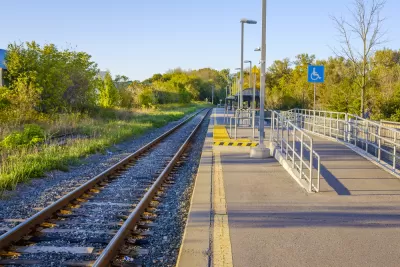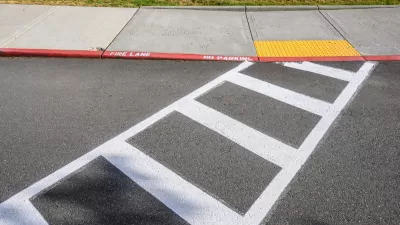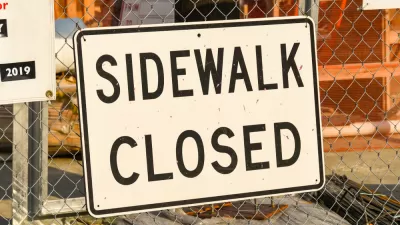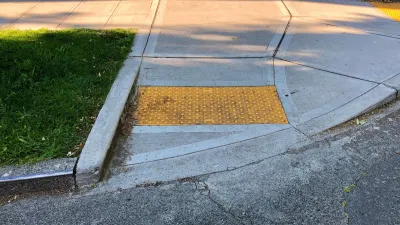Decades of advocacy are paying off, but it often takes legal action to force cities to make accessibility improvements mandated by the Americans with Disabilities Act over thirty years ago.

The Americans with Disabilities Act, known as the ADA, is a federal law passed in 1990 aimed at prohibiting discrimination against people with disabilities and ensuring physical accommodations in public spaces and buildings with public access. As explained in this Planopedia entry about the ADA, “Title III of the ADA requires accessibility improvements in privately owned properties. People with disabilities have the right to full and equal enjoyment of any privately owned property with public accommodations, including commercial, retail, and other kinds of land uses.”
Yet in the decades since its passage, many cities have failed to upgrade their public infrastructure to comply with ADA requirements. For many people with disabilities, getting around American cities remains a challenge that can prevent them from getting to jobs, medical appointments, or other daily needs. For people with mobility, vision, or other impairments, simply navigating the public realm can be a difficult and dangerous endeavor. While able-bodied people may be able to nimbly maneuver around an obstacle blocking a walkway or a broken sidewalk, others are forced to put themselves in the path of traffic or make long detours. Meanwhile, as of 2020, less than 1 percent of single-family homes were move-in ready for a resident using a wheelchair.
Now, as disability rights advocates around the country take legal action against cities to force changes, the public realm is finally becoming more accessible to all, thanks to the hard work of people who call attention to the urgency of the issue. Here’s a roundup of recent ADA compliance victories.
- New York City must make 95 percent of subway stations accessible via elevators or ramps by 2055, a timeline some activists deem unacceptable. Riders are also suing the MTA to get the agency to reduce the gaps between platforms and trains, which pose a danger to wheeled devices.
- In Los Angeles, an investigation by the U.S. Attorney’s Office revealed that Union Station, the city’s downtown transit hub, the largest passenger railroad terminal in the Western U.S., and an architectural crown jewel, is not “readily accessible to and usable by individuals with disabilities.” Los Angeles Metro is tasked with hiring an independent architect to assess and remediate the accessibility deficiencies in the station.
- A lawsuit is forcing the city of Philadelphia to add or improve 10,000 curb cuts over the next 15 years. Last month, the city’s Southeastern Pennsylvania Transportation Authority (SEPTA) contracted with a design firm to install accessibility upgrades at three of its subway stations. The agency also received a $56 million federal grant in December to help cover the cost of accessibility improvements at five other stations.
- Accessibility doesn’t just mean ramps. In Chicago, a federal judge ruled that the city must install accessible pedestrian signals (APS’s) at crosswalks to improve mobility for people with vision impairments. The city also lacks accessibility accommodations at roughly two-thirds of its elections polling stations.
- As a result of lawsuits, four Michigan cities will make ADA upgrades to their intercity rail stations.
- Asheville, North Carolina approved an expansive ADA compliance plan in October 2022 dubbed Close the GAP that identifies priority areas for ADA improvements.
- A pandemic-era road closure in Washington, D.C.’s Rock Creek Park, made permanent last November, has been hailed as a victory for universal accessibility.
A case before the U.S. Supreme Court will decide the future of ‘testers,’ disability rights advocates who purposely seek out ADA violations without intending to use a particular service. The case centers on a woman who searches hotel websites and brings suits against those who don’t provide ADA-mandated information about accessibility accommodations. The hotel argues that the woman has no standing because she never intended to actually stay at the hotel.
Universal benefits and the ‘curb cut effect’
Promoting accessibility for people with mobility challenges, vision impairment, neuro-cognitive disorders, and other disabilities often benefits much larger segments of society through what is known as the ‘curb cut effect.’
In the case of curb cuts, by designing public facilities to accommodate wheelchair users, planners inadvertently made those spaces more friendly and accessible to parents with strollers, people wheeling heavy luggage, elderly people with walkers, children on bicycles, and others. Thinking about women and other vulnerable groups in urban design—for example, installing brighter street lighting and emergency phones—can improve public safety for everyone. Designing for children, who experience the city from a lower vantage point and with less background knowledge than adults, can make roads safer for all pedestrians.
Universal design focuses on making buildings and other spaces accessible and usable to as many demographics as possible and centers dignity for all road users. A universal design guide from the American Society of Landscape Architects (ASLA) “defines universal landscapes as accessible, participatory, comfortable, ecological, predictable, multi-sensory, walkable, and predictable.” Supporters of universal design point out that mobility can have powerful ripple effects on people’ access to education, jobs, food, medical care, and other essential needs.

Alabama: Trump Terminates Settlements for Black Communities Harmed By Raw Sewage
Trump deemed the landmark civil rights agreement “illegal DEI and environmental justice policy.”

Study: Maui’s Plan to Convert Vacation Rentals to Long-Term Housing Could Cause Nearly $1 Billion Economic Loss
The plan would reduce visitor accommodation by 25% resulting in 1,900 jobs lost.

Planetizen Federal Action Tracker
A weekly monitor of how Trump’s orders and actions are impacting planners and planning in America.

Wind Energy on the Rise Despite Federal Policy Reversal
The Trump administration is revoking federal support for renewable energy, but demand for new projects continues unabated.

Passengers Flock to Caltrain After Electrification
The new electric trains are running faster and more reliably, leading to strong ridership growth on the Bay Area rail system.

Texas Churches Rally Behind ‘Yes in God’s Back Yard’ Legislation
Religious leaders want the state to reduce zoning regulations to streamline leasing church-owned land to housing developers.
Urban Design for Planners 1: Software Tools
This six-course series explores essential urban design concepts using open source software and equips planners with the tools they need to participate fully in the urban design process.
Planning for Universal Design
Learn the tools for implementing Universal Design in planning regulations.
Caltrans
Smith Gee Studio
Institute for Housing and Urban Development Studies (IHS)
City of Grandview
Harvard GSD Executive Education
Toledo-Lucas County Plan Commissions
Salt Lake City
NYU Wagner Graduate School of Public Service






























